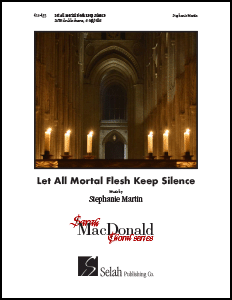|
Composer
Stephanie Martin
Text Liturgy of St. James, ca. 5th cent., tr. G. Moultrie
Voicing SATB, double chorus, a cappella
Topics Communion
Lectionary usage Advent, Christmas
Price $2.95 (U.S.)
Length 3' 15" Released 1/2020
Catalog no. 410-435
Difficulty Difficult
|
Order now!
Order PDF download!
Min. of 5
Description
Stephanie Martin served as director of music at the famed Church of Saint Mary Magdalene in Toronto, with its weekly tradition of contrapuntal unaccompanied sacred music. Her mastery of this idiom is in evidence in this expansive chorale motet based on the familiar hymn melody and text. Scored for double choir, the music unfolds gradually, building to intense climaxes and finally to a resplendent conclusion. The eight independent parts are active throughout, and the music is best suited to an experienced or large choir.
Text
Let all mortal flesh keep silence,
and in fear and trembling stand;
ponder nothing earthly-minded,
for, with blessing in his hand,
Christ our God to earth descendeth,
our full homage to demand.
King of kings, yet born of Mary,
as of old on earth he stood,
Lord of lords, in human vesture,
in the body and the blood,
he will give to all the faithful
his own self for heav'nly food.
Rank on rank the hosts of heaven
spreads its vanguard on the way,
as the Light of light descendeth
from the realms of endless day,
that the pow’rs of hell may vanish
as the darkness clears away.
At his feet the six-winged seraph,
cherubim, with sleepless eye,
veil their faces to the presence,
as with ceaseless voice they cry,
"Alleluia, alleluia,
alleluia, Lord most high!"
--Liturgy of St. James, ca. 5th cent.;
tr. G. Moultrie (1829–1885).
|
|


Review
"These atmospheric words from the Liturgy of St. James often call forth impressionistic responses from composers, and this setting is well within this tradition. If anything, Martin's approach pushes this genre into even more hazy vistas, creating an even more exalted vision. The opening measures build a claustrophobic stacking of pitches as subsequent entries add to dense cluster chords. Following a dozen measures of introduction, choir one begins the familiar PICARDY melody as choir two continues the mysterious texture of the opening. Fragments of the tune enter in other tonal areas to a dazzling effect. As the music gains intensity, Martin varies the rhythmic organization, including off-kilter measures of 3/8 and generally destabilizing the meter. An impassioned, charged climactic section achieves a brilliance matching the cosmic nature of the text. The music quickly recedes into tranquility that nonetheless retains a sense of mystery. The charged chromaticism of the preceding passage fades slowly as the music returns to a somber D minor. Choir one picks the tune of PICARDY back up as choir two slowly intones repeated alleluias in sustained halfnote chords. The anthem crescendos one final time for a final, triumphant conclusion of 'Alleluia, Lord most high!' This choral fantasia makes a fair number of demands on the choir, requiring a proficient ensemble with enough voices to fill out the eight-part harmony. Its immediately engaging manner promises to make it a popular choice for congregations and singers alike." -AAM Journal, March 2020 |



